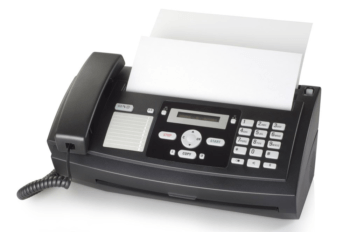The Rise And Fall Of The Fax Machine

If the fax machine is not dead, it is certainly on life support. Its story is a classic example of how one technology can change ideas and expectations quickly, and faster than you can say Betamax, shows how people and commerce are eager to adapt the next best thing, says a Texas A&M University professor who has authored a book on the subject.
Jonathan Coopersmith, an associate professor of history who specializes in the history of technology, has written Faxed: The Rise and Fall of the Fax Machine, and like the rise and fall of the Roman Empire, the fax machine ascended to the top of the business machine world only to go “kerplunk” on its own successes.
The fax – which comes from fac-simile, the term that Scottish inventor Alexander Bain coined for the device that he invented in, believe it or not, 1843 – was meant to be the best way to transmit messages quickly and accurately by sending an actual image of the message, unlike telegrams which often suffered from errors caused by the telegraph operators.
“The problem was that the early inventors, including Thomas Edison, could not make faxing succeed, either financially or technologically as they needed,” Coopersmith explains.
“It was a great idea, but it sort of bounced around for several decades without much success. The first commercial application occurred in Paris in the early 1860s, but the first profitable use did not occur until AT&T and the Associated Press introduced Wirephoto in 1935. For the first time, photographs could be transmitted as fast as the telegraphed story. Newspapers were the first early adopters.”
What really caused the technology to advance was World War II, when the military needed to send maps and photographs to very distant locations.
“Throughout history, when the military gets involved in just about anything, such as airplanes, it’s been a huge boost for the technology because it has the money and the manpower to make things happen much quicker regardless of the economics,” he notes.
The fax machine continued to be improved with the military as the main market until the 1970s. Xerox and other companies jumped on the bandwagon for faxing business correspondence in the 1960s and 70s, all trying to improve speed and clarity. Three big problems at the time limited faxing: transmitting one page took six minutes, fax machines were not cheap and competing firms offered incompatible equipment.
“Until the 1970s, it was about 10 to 100 times more expensive to send a fax than just sending something by U.S. mail,” Coopersmith notes. “As for the time to send a fax, that proved to be a stumbling block for several years – it took a long time to transmit a 20- or 40-page document.
“By the early 1980s, the technology had improved so that you could transmit one page in about 20 seconds. In a virtuous cycle for consumers, Japanese manufacturers viciously competed against each other, continually offering better and cheaper machines. Yet they also cooperated to ensure compatibility among competitors.”
Suddenly, fax machines were all the rage and every office had at least one.
“People and companies loved them so much that their popularity showed in how people spoke: fax became a verb, as in ‘fax me the papers,’” he says.
But digital communications hit big-time in the mid-90s with the advent of the Internet, the World Wide Web, and email, and within a few years, the fax machine went the way of the crew cut.
Large documents, even entire books, could be transformed into PDF files or stored online, making faxes near obsolete. The once much-needed fax machine gathered dust in the corner.
“Email just changed everything,” Coopersmith, who still has a fax machine in his office, says.
“Many offices today still have a fax machine, but mainly they serve as a back-up in case there is a problem with email. Real estate firms and pharmacies still use them frequently, and they are still very popular in Japan because the older population there still favors them. But overall, the fax machine has been replaced by something else. Today, kids don’t really know what one is because a smart phone can do what a fax machine could 25 years ago. The tweet is where it’s at today, not a fax.
“So we have gone from the telegraph to the telephone, from fax machines to smart phones, each one replacing something else by offering less expensive, easier and more inclusive communications. It makes you appreciate the changing nature of technology, and it makes you ask yourself, ‘what happens next?’”
Media contact: Keith Randall, Texas A&M News & Information Services.





